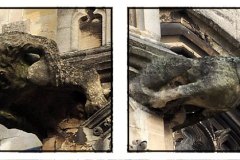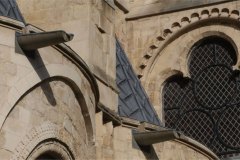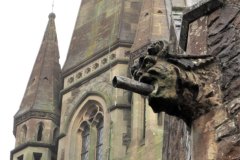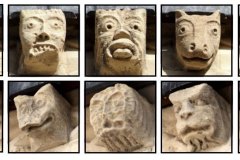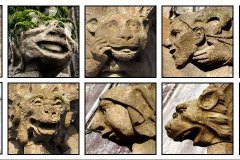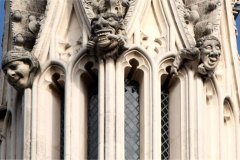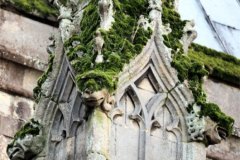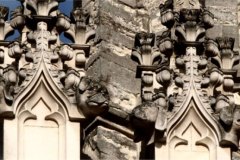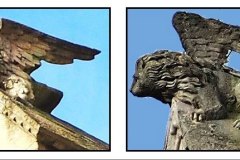Cathedral’s Rooftop Fantasies
High above the Cathedral precincts is a fantasy land of carved heads and monsters, with gaping mouths, lolling tongues, bared teeth and strange limbs. These are the gargoyles and grotesques – hardly discernible from the ground – that were originally put there in the medieval period to ward off evil spirits. They are the external equivalent of the grotesques carved on the pillars in the crypt.
Gargoyles
These are grotesques with a spout to throw rainwater away from the wall – the word is thought to come from the Old French for throat, gargouille. The cathedral has few of these. If there were many in the past they have been replaced by drainpipes – for instance the north nave drainpipes are dated 1755 and the south nave 1760. There are two typical gargoyles (image 1) on the corners of the south-west porch, but this also, now has a drainpipe. There are water gulleys where there might once have been gargoyles, for instance on the apses of the south-east transept (image 2) – these were installed during a recent refurbishment, replacing drainpipes. Possibly the nearest working gargoyles in Canterbury are those on the neo-gothic chapels (image 3) built in the 1870s for the city cemetery in Westgate Court Avenue.
Grotesques
These are sometimes called chimerae. The cathedral heights, particularly on the pinnacles to buttresses and towers, have dozens, well into three figures in all, although their features are difficult to make out from ground level. However, there are many others nearer the ground including on the west towers and round the cloister garth.
The corbels around the top of the south-east transept stair tower are possibly the oldest surviving grotesques that can easily be seen (image 4), although at least one is obviously a modern replacement.
All the stone pinnacles to the buttresses of the nave and its aisles have four grotesques (image 5) including many dog heads. The pinnacles were erected in the middle of the 19th century in place of wooden ones installed by Jesse White, the cathedral surveyor who had a reputation for replacing stone with wood – he was also the surveyor responsible for removing the turrets of Christchurch Gate.
Where to look (best with binoculars)
- South-west porch
- Pinnacles on nave buttresses and south-west transept
- Top of staircase tower, south-east transept
- Cloister garth arcades
- Western towers
- On Trinity Chapel buttresses there is an eagle and a winged lion
Sources:
Memorials Of Canterbury Cathedral, C. Eveleigh Woodruff and Canon William Danks, 1912, Chapman & Hall Ltd.
For general background: Gargoyles And Grotesques, Alex Woodcock, 2012, Shire Publications.
J.P.D.

